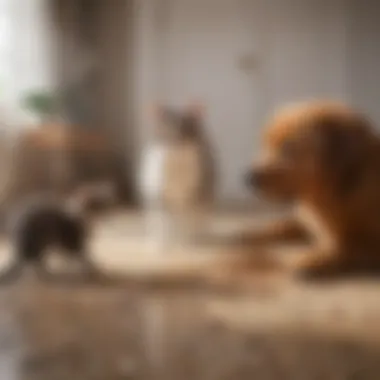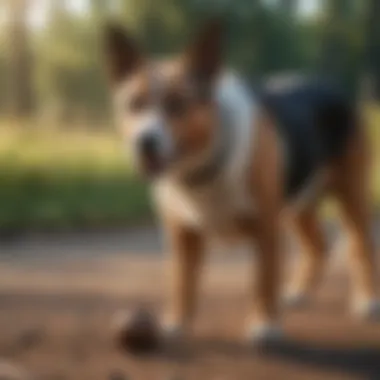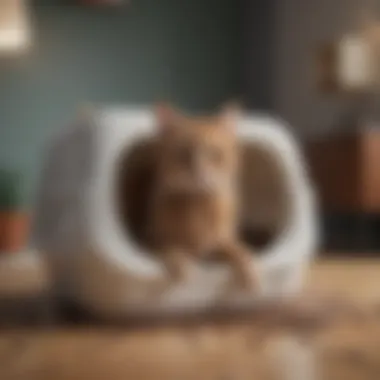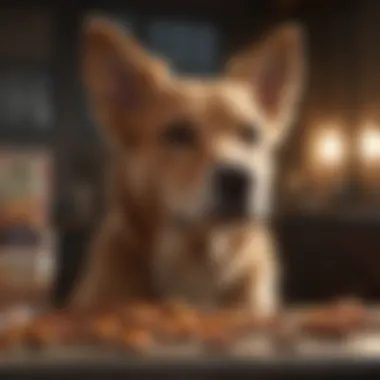Effective Strategies to Prevent Dogs from Eating Cat Feces


Intro
The phenomenon of dogs consuming cat feces, commonly referred to as coprophagia, is more prevalent than one might expect. This behavior can be perplexing and frankly disturbing for pet owners. Understanding why dogs engage in this practice is key to effectively addressing it. By adopting a multifaceted approach—considering behavior, environment, and diet—owners can take actionable steps to discourage their dogs from this unappealing habit.
This article will offer insights into the motivations behind this behavior, explore practical solutions, and synthesize various strategies for intervention and prevention.
Animal Overview
Common Name and Scientific Classification
Dogs (Canis lupus familiaris) and cats (Felis catus) are both popular domestic animals. Understanding their classification and behavioral patterns can shed light on the dynamics of coprophagia.
Physical Characteristics
Dogs exhibit a wide range of physical traits, depending on the breed. Generally, they possess acute senses of smell and taste, which can draw them to feces as a source of information or nutrition. Cats, on the other hand, are more inclined to bury their waste, an instinctive behavior linked to their survival.
Habitat and Distribution
Dogs can be found in various environments—from urban settings to rural landscapes—often sharing space with household cats. This close proximity between the two species sets the stage for potential coprophagic behavior among dogs.
Understanding Canine Instincts
In dogs, certain instincts can compel them to consume feces. This includes behavior rooted in pack biology where scavenging reflects a survival tactic. Coprophagia can also stem from behavioral issues such as anxiety or boredom.
Evaluating the Environment
The home environment plays a significant role in influencing a dog's habits. Consider the composition of your household, including the number of pets, their behaviors, and how litter boxes are managed. A clean and organized space can deter dogs from engaging in this habit.
Effective Strategies to Discourage Coprophagia
Understanding the underlying causes of this behavior means you can tailor specific strategies to address it.
- Training Techniques: Employ positive reinforcement when your dog engages in appropriate behaviors, redirecting them away from feces with firm commands.
- Dietary Adjustments: Ensure your dog is fed a balanced diet. Sometimes, nutrient deficiencies can lead to canine fecal consumption. Consult your veterinarian regarding specialized diets or supplements.
- Environmental Control: Placing litter boxes in hard-to-reach areas or using dog-proof boxes can greatly limit your dog's access to cat feces.
"Prevention is crucial. By managing the environment and understanding canine instincts, owners can significantly reduce occurrences of coprophagia."
Culmination
Curbing the behavior of dogs consuming cat poop is multifaceted, involving behavioral understanding and practical strategies. By applying thoughtful training, environmental adjustments, and proper diet, pet owners can effectively manage this habit and foster a cleaner living space. This comprehensive approach empowers owners to take control over their pet's behavior, leading to a healthier coexistence between cats and dogs.
Understanding the Behavior
Understanding why dogs engage in the habit of eating cat feces is a crucial first step toward finding effective solutions. This behavior, coprophagia, is often perplexing to pet owners, who might view it as undesirable and unhygienic. However, exploring the reasons behind this behavior can lead to targeted interventions that address the root causes, rather than merely attempting to suppress the action.
By gaining insights into the motivations for coprophagia, pet owners can tailor their approaches to discourage this habit. This understanding can also foster a better relationship between the dog and the owner, building a more harmonious environment in the home. Awareness of both behavioral and dietary factors plays a significant role in mitigating this issue.
What is Coprophagia?
Coprophagia is the term used to describe the act of consuming feces, a behavior that can be observed in various animals, including dogs. Although often deemed repulsive by humans, for dogs, this behavior is not inherently abnormal. Various biological and psychological factors contribute to the likelihood of a dog exhibiting coprophagia. Grasping this concept allows pet owners to approach the issue with greater empathy and informed strategies.


Underlying Reasons for the Behavior
Instinctual Drives
Instinctual drives account for a significant portion of coprophagic behavior in dogs. Dogs, like their wild counterparts, often display behaviors anchored in survival instincts. In nature, consuming feces can serve specific purposes such as nutrient retrieval and scent masking. This instinct underscores an adaptive strategy that has likely been ingrained in canine behavior over generations. While it may not be useful in a domesticated context, recognizing this instinct can help owners comprehend why their pet engages in this behavior.
Nutritional Deficiencies
Nutritional deficiencies are another common factor that may lead to coprophagia. Pets may seek out feces to obtain nutrients they are lacking in their diets. If a dog’s diet is not balanced or lacks critical vitamins and minerals, the dog may look to cat feces as a supplementary source of these nutrients. This explanation emphasizes the importance of a well-rounded diet tailored to the specific needs of the dog. Ensuring proper nutrition can help mitigate the urge to consume fecal matter.
Behavioral Factors
Behavioral factors also contribute significantly to this phenomenon. Stress or anxiety can cause dogs to engage in coprophagia as a coping mechanism. Reactions to environmental changes, such as new household members or changes in routine, may prompt this behavior. Addressing underlying behavioral issues through training and proper socialization can effectively reduce the likelihood of coprophagia. Pets thrive on stability, and ensuring a structured environment can facilitate more positive behaviors.
Identifying the Triggers
Identifying the triggers of a dog's habit of eating cat feces is critical for understanding and addressing this behavior. When you recognize the specific reasons behind this coprophagia, you can implement more effective interventions. Each dog's motivation for this act might vary, and an informed pet owner can take tailored actions to mitigate the issue.
Environmental Factors
Access to Litter Boxes
Access to litter boxes is a primary factor influencing a dog's tendency to consume cat feces. If a dog has easy access to these boxes, it will naturally explore what's inside. This behavior is not merely curiosity; it is often driven by instinctual urges. Many dogs find the scent of cat feces appealing, as it can be reminiscent of food, leading to this unwelcomed habit.
A key characteristic of litter box placement is how it enables or prevents access for the dog. If the litter box is situated in an easily accessible area, dogs will likely discover it and the feces within. As a preventive measure, owners should consider relocating the box to a place where the dog cannot reach it. This choice is practical and often necessary to tackle the habit of coprophagia effectively. While it may involve inconveniencing the cats, it is a temporary solution aimed at curbing this problematic behavior.
Presence of Cat Feces Outdoors
The presence of cat feces outdoors is another significant factor in triggering dogs to engage in this behavior. Dogs that roam freely may come across feces left by outdoor cats, and their instinctual drives might compel them to consume it. The smell and the foreignness of the feces can spark interest, making them want to investigate further.
Highlighting this factor is essential because it emphasizes the broader implications of allowing dogs unsupervised access to outdoor spaces. Pet owners must be aware of their dogs' surroundings, particularly in areas where cats might wander. This situation can lead to multiple cases of coprophagia, making it a common issue among dog owners who have pets sharing outdoor environments. Keeping dogs on leashes or in fenced areas can significantly decrease the chances of encountering feline feces, thus lessening the incidence of this behavior.
Stress and Anxiety Influences
Stress and anxiety can significantly influence a dog's behavior, including its propensity to eat feces. Dogs often resort to such habits as coping mechanisms during times of distress. A change in environment, loss of a companion, or even loud noises can trigger anxiety in dogs. This scenario often leads them to engage in peculiar behaviors as a means of self-soothing or stress relief.
Understanding these influences is crucial for owners who are concerned about their dog's health and behavior. Addressing the root causes of stress or anxiety may eliminate or reduce the compulsion to engage in coprophagia. Owners might find it beneficial to implement calming strategies or behavioral training to promote stability in their dogs' interactions with their environment.
Preventive Measures
Preventing a dog from eating cat poop involves a multi-faceted approach. This section outlines effective methods to deter dogs from this behavior. It is essential to bear in mind that habits are often reinforced if not directly addressed. Therefore, implementing preventive measures will benefit both the dog and the overall health of the household. Establishing a consistent routine and employing the right techniques can significantly reduce the chances of this behavior occurring.
Training Techniques
Basic Commands
Basic commands serve as the foundation of dog training. Teaching commands like "leave it" or "no" can directly stop a dog mid-action. The clear characteristic of basic commands lies in their universal application. They can be used in various situations beyond the realm of coprophagia. Basic commands are a beneficial choice for discouraging undesirable behaviors.
A unique aspect of basic commands is their versatility. Once learned, they can help control many situations, enabling dog owners to manage their pets effectively. When executing these commands, consistency is crucial. Owners must repeat them often until the dog understands the expectation. The advantages of basic commands include fostering good communication between the pet and owner. However, an initial investment of time and effort to teach these commands is essential.


Employing Positive Reinforcement
Positive reinforcement involves rewarding desired behaviors. This technique helps reinforce the actions the pet owner prefers. The fundamental attribute of positive reinforcement lies in its ability to promote a sense of understanding rather than fear. This makes it a beneficial choice for training dogs, as it encourages a bond based on trust.
A unique element of positive reinforcement is its adaptability. Different types of rewards, such as treats or praise, can cater to a dog's individuality. The main advantage is that it tends to yield long-lasting results; dogs often remember pleasant experiences. One disadvantage, however, is the necessity for timing. Rewards must be given promptly to ensure the dog associates them with the right behavior.
Restricting Access
Managing Litter Box Placement
Managing litter box placement is a strategic method to limit a dog's access to cat feces. This approach focuses on ensuring that litter boxes are in less accessible locations. The essential aspect of managing litter box placement is its effectiveness in reducing the chance for the dog to discover cat poop. By positioning the litter box in an area not easily reachable by the dog, pet owners can mitigate the problem significantly.
The unique feature of this approach is its simplicity. It often requires minimal effort but can lead to substantial results. Ensuring that the cat's litter box is in a secure space, such as a room with a closed door, reduces coprophagia opportunities. Thus, one major advantage is that it does not involve direct training. A potential downside may be the need for more monitoring of the cat, as they also require privacy.
Using Fencing or Barriers
Using fencing or barriers is another preventive measure against dogs accessing cat food or feces. This method is effective in creating physical boundaries to sections of the house or yard. The key characteristic of fencing or barriers is providing a straightforward solution to prevent unsupervised interactions between dogs and cats. This method is a beneficial choice if multiple pets are involved in the household.
A unique aspect of fencing or barriers is customization. Depending on the household layout, different types of barriers may be applied, from baby gates to outdoor fences. One distinct advantage includes the fact that it allows both pets to have separate spaces without conflict. A disadvantage, however, might include additional costs related to installation or maintenance of the fences and barriers.
Dietary Considerations
Diet plays a crucial role in addressing the issue of dogs consuming cat feces, which is commonly known as coprophagia. By thoroughly evaluating and modifying a dog's diet, pet owners can significantly influence their dog's urges and behaviors. A nutritionally balanced diet not only fulfills a dog's physical needs but may also reduce the likelihood of undesirable habits that stem from nutritional deficiencies. This section delves into the significance of dietary considerations, focusing on the importance of nutritional assessments and the incorporation of supplements to enhance overall health and behavioral management.
Nutritional Assessment
Conducting a nutritional assessment is imperative for understanding whether a dog's diet is adequate. A well-balanced diet provides essential nutrients that can prevent cravings for items such as cat feces. Pet owners should examine the dog’s current food choices and nutritional content. Ingredients should include high-quality protein sources, fats, vitamins, and minerals to support canine health.
It is beneficial to consult with a veterinarian or a pet nutrition expert. They can help determine if the dog’s nutritional needs are being met. Common indicators of inadequate diets may include weight loss, lack of energy, or digestive issues. By identifying gaps in the dog's diet, owners can make informed decisions about dietary adjustments, which in turn may help curb the behavior of eating cat poop.
Enhancing Diet with Supplements
To address specific dietary deficiencies, pet owners might consider including supplements in their dog’s diet. Two notable types of supplements are:
Digestive Enzymes
Digestive enzymes can improve the breakdown of food in a dog's gastrointestinal tract. This supplementation can lead to better nutrient absorption and reduce the chances of coprophagia. The key characteristic of digestive enzymes is their role in enhancing digestion and nutrient assimilation. They often serve to compensate for any inherent deficiencies in the dog’s natural enzyme production, perhaps due to an inadequate diet or health conditions.
A popular choice for many pet owners, digestive enzymes are known for their ease of use and positive effects on overall health. However, it is essential to introduce them gradually and consult a veterinarian on appropriate types and dosing. The unique feature of digestive enzymes is that they can target specific digestible materials, enhancing their efficiency, thereby reducing the dog's urge to seek out additional sources of nutrients, such as cat feces. There can be disadvantages, though, such as potential digestive upset if introduced too quickly.
Probiotics
Probiotics have gained attention in the realm of pet nutrition, as they contribute to a well-functioning digestive system. These beneficial bacteria help balance gut flora and can enhance overall health. The key characteristic of probiotics is their ability to promote a healthy gut environment, which can alleviate any gastrointestinal distress that may lead to coprophagia.
Many pet owners find probiotics beneficial as they can often be easily added to the diet through various forms, including powders or chews. Their unique feature lies in their capacity to support immune function and improve digestion. Advantages include reducing the frequency of bloating or gas that can cause dogs to seek food elsewhere, including unpleasant sources like cat feces. However, it is beneficial to consult with a veterinarian to determine the right strains and doses, as improper use could lead to inefficacy or mild side effects.
It is essential to strike a balance in diet and supplements to promote a healthy and happy dog.
Adjusting a dog's diet with high-quality food and appropriate supplements is an effective strategy in discouraging coprophagia. By focusing on the nutritional aspect, pet owners can make strides in preventing the potentially harmful habit of dogs eating cat waste.


Behavioral Modification Strategies
Behavioral modification strategies are pivotal in addressing the issue of dogs consuming cat feces. Understanding these strategies offers insights into how to redirect a dog's natural instincts in a more desirable manner. The objective is to implement techniques that not only deter this behavior but also enrich the dog's daily experiences. By focusing on changing behavior through structured approaches, pet owners can foster an environment that decreases the likelihood of coprophagia.
Redirecting Attention
One effective method for addressing coprophagia is redirecting a dog's attention. This technique involves encouraging alternative behaviors when a dog shows interest in cat feces. For instance, pet owners can engage their dogs in play or training exercises as soon as they notice them trying to reach cat poop. This strategy not only distracts the dog but also enhances the bond between pet and owner by incorporating positive interactions. An active approach ensures that the dog focuses on more engaging tasks, making the temptation to consume cat feces less appealing.
Using Deterrents
Utilizing deterrents can significantly help in preventing dogs from eating cat feces. Such methods can vary, including both commercial products and homemade solutions.
Commercial Products
Commercial products designed to deter dogs from consuming cat feces often contain specific ingredients that make feces taste unpleasant for the dog. These products work by providing a strong taste that discourages ingestion. An important characteristic of these deterrents is their ease of use. Many pet owners find commercial deterrents convenient since they require minimal effort to apply. However, while effective, these products may not work for every dog. Some dogs may develop a tolerance to certain tastes. Additionally, pet owners must monitor their dogs for any reactions to these substances, ensuring they choose products that are safe and suitable for their pets.
Homemade Solutions
Homemade solutions can also be valuable in tackling coprophagia. These often involve ingredients that are safe and common in many households. For example, mixing certain spices with cat feces, such as cayenne pepper or bitter apple, can create an unpleasant taste that deters dogs. The key aspect of homemade solutions is that they can be tailored specifically to the dog's preferences and tolerances. However, a notable drawback is the potential variability in effectiveness; what deters one dog may not affect another. Still, these solutions generally allow for more control over ingredients and can be a cost-effective alternative to commercial products.
When to Seek Professional Help
Addressing the habit of dogs consuming cat feces, known as coprophagia, can sometimes escalate beyond typical behavioral training. Recognizing when to seek professional help is paramount to ensure the well-being of both the dog and the household environment. Various aspects are worth considering when determining if expert intervention is necessary.
Recognizing Severe Cases
Some instances of coprophagia can indicate deeper issues. It is essential to be vigilant for signs that suggest the behavior may not simply be a habit, but rather stem from underlying health problems or extreme behavioral disorders. Here are some indications of severe cases:
- Persistent Behavior: If your dog continuously exhibits this habit despite consistent training and behavioral modification, it may signal an underlying issue.
- Changes in Health or Mood: Any sudden changes in appetite, weight, or overall demeanor warrant attention. Increased lethargy or signs of distress can point to potential health complications.
- Signs of Digestive Issues: Look for symptoms such as excessive gas, vomiting, or diarrhea. These can correlate with issues in the gastrointestinal tract, which might also drive the coprophagia behavior.
Observing and documenting these patterns can provide valuable information when consulting with a veterinarian.
Benefits of Consulting a Veterinarian
Engaging a veterinarian can be an invaluable step in managing coprophagia. Their expertise can shed light on elements that are often overlooked. Consulting a veterinarian brings several advantages:
- Comprehensive Health Assessment: A vet can conduct a thorough examination to rule out any medical conditions that could be influencing the behavior. Conditions like parasites or gastrointestinal disorders often can lead to unusual eating habits.
- Tailored Advice: Professionals can offer specific recommendations based on the dog’s health history, breed, and lifestyle. This tailored advice can include nutritional adjustments or alternative behavioral strategies.
- Refer to Specialists if Necessary: If the behavior exhibits severe psychological elements, the veterinarian may suggest referral to a veterinary behaviorist for further assessment and intervention strategies.
End
In closing this article, it is essential to distill the various aspects we have discussed regarding the behavior of dogs consuming cat feces. Addressing coprophagia is a multifaceted endeavor that involves understanding the underlying motivations, implementing preventative measures, and embracing a responsible approach to pet ownership.
Summary of Effective Strategies
To effectively combat this behavior, pet owners should consider several strategies:
- Training Techniques: Employ basic commands that encourage a dog to focus on the owner rather than the litter box. Positive reinforcement can help in creating a desirable alternative behavior.
- Dietary Adjustments: Ensuring that dogs have a balanced diet and addressing any potential nutritional deficiencies can minimize the desire to engage in coprophagia. Supplements might also help.
- Restricting Access: Managing the environment is key. This includes placing litter boxes in less accessible areas or creating physical barriers to cat feces outdoors.
- Consulting Professionals: When behavior persists, seeking help from veterinarians or animal behaviorists can yield tailored solutions that take the specific needs of the dog into account.
Implementing these strategies will not only aid in diminishing the unfortunate habit of ingesting cat feces but will also contribute to a healthier and more harmonious household environment.
Encouraging Responsible Pet Ownership
Responsible pet ownership must remain at the forefront of any discussion regarding pet behavior. Pet owners should realize that behaviors such as coprophagia often reflect larger issues, whether they be environmental or health-related. It is vital to maintain open lines of communication with veterinary professionals.
- Commitment to Training: Dedicating time to training is a hallmark of responsible ownership. It lays the groundwork for a trusting relationship between dog and owner.
- Health Monitoring: Regular vet checkups are indispensable in ensuring that the pet is healthy and that any behavioral issues are understood in context.
- Research and Education: Owners are encouraged to educate themselves about canine behavior and nutrition continuously. Engaging with resources like Wikipedia, Britannica, and forums on Reddit may provide further insights.
In summary, stopping a dog from eating cat poop requires proactive measures, education, and a commitment to the well-being of all pets involved. Encouraging responsible pet ownership is not only beneficial for the pets but is also paramount for the mental and emotional satisfaction of the owner.







